 Metroid . . . Pinball. Sound like a good mix to you?
Metroid . . . Pinball. Sound like a good mix to you?
Well despite what may come to your mind when mixing an established series with pinball (Like Sonic or House of the Dead) Metroid Prime Pinball takes everything that was great about Metroid Prime, such as beautiful, well-rendered graphics and good music, and manages to mix up the Pinball genre itself by adding in all the elements that you’d expect from a pinball take on Metroid (Not to mention the game ships with a Rumble cart that slips into the GBA slot on your DS, a nice bonus).
From power-ups like Missiles and Power Bombs, to unique pinball elements like electricity to keep your ball from falling through the main flippers and down the drain to boss fights, Metroid Prime Pinball does exactly what you’d expect, yet adds enough that you don’t expect to make it feel fresh and fun.
There haven’t been a whole lot of great video game pinball games, probably only a handful throughout the years, but Metroid Prime Pinball for the Nintendo DS can safely and easily be added to that list.
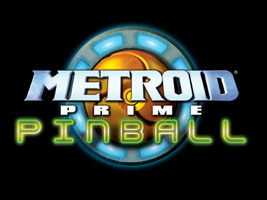
System: Nintendo DS
Also On: None
Genre: Isometric Action Video Game Pinball
Release Date: Oct. 24, 2005 (US) – Dec. 1, 2005 (AUS) – Jan. 19th, 2006 (JAP) – June 22, 07 (EU)
Save: Cart (Auto Saves High Scores)
Players: 1-8
Developer: Fuse Games
Publisher: Nintendo
Rating: E for Everyone
Metroid Prime Pinball is a pinball spin on the Metroid series by developer Fuse Games (the same guys behind Mario Pinball Land for Game Boy Advance). It takes Samus Aran, the female protagonist from the Metroid series, and places her on various pinball tables (In Morph Ball Mode of course) based on environments from Samus’ 3D GameCube adventure Metroid Prime.
When playing on a specific table, the playfield is spread out over both the bottom and top DS screens which make one large screen. The viewpoint remains static, but that’s not a problem at all as you can fully see everything and it doesn’t take much to get used to watching your ball fall between screens when rolling around the playfield.
Like real pinball, most of the mechanics are the same. You’ve got your two flippers (with sometimes 1 or 2 more near the middle) at the bottom of each table which you use to knock the ball back up onto the playfield. Beyond the bottom flippers is the drain. If the ball goes between the flippers and into the drain, you lose that ball (and lose a life if you only have one active ball on the playfield). While most pinball games, even electronic ones, will contain a plunger (a spring that the player can pull back and when released it knocks the ball into the playfield. A skilled player can use just the right amount of force to knock the ball to a certain place on the field), in Metroid Prime Pinball the ball is automatically flung into the field and the player has no control over it.
Also in the middle of all the boards, between the flippers, are a few icons that you will want to keep your eye on. The most obvious is the score, which is a light-up blue display, and like most pinball games most everything you hit will add points to your score. Below the score (which is like a big blue banner) are various icons placed around in a circle. The middle of the circle is known as the “Combat Saucer”, you will roll over this when “Combat Mode” is activated (more on this in a bit). 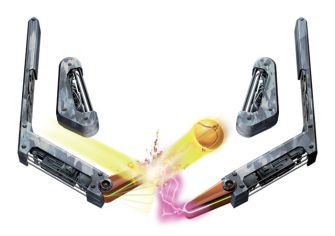
Blue round slots that go around in a circle represent your health, being hit by enemies can take away a slot of health, and if it’s depleted entirely poor Samus will blow-up. To the left are four missile icons (showing you how many you have left), and to the right are three Bomb icons. You can only lay three bombs at a time, and if it’s drained you’ll have to wait for it to recharge before you can drop more. Above the Bomb icons is the Power Bomb Icon, and this will be lit when you have obtained the Power Bomb. You can only hold one Power Bomb at a time.
At the bottom of this circle of icons is your life counter in blue (represented by Samus’ Morph Ball), obviously you’ll want to keep your eye on this. You start out each game with three lives where zero counts as your last. Finally, directly above the score are letters that spell “Samus”, you can light these by going up ramps with a blue arrow, and when all of them are lit then Combat Mode can be entered by rolling over the Combat Saucer in the middle of all these icons.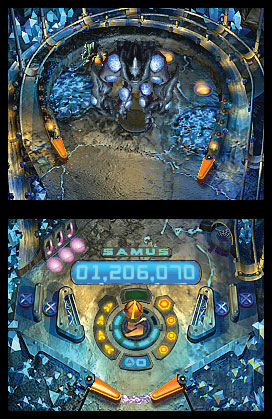
The various tables in Metroid Prime Pinball are filled with ramps and rails to carry the ball to different parts of the playfield. Objects on the tables include bumpers (which increase your score) and various targets for you to hit, as well as various rollovers, which are targets that activate when you roll over them, with varying results (usually they will light up when rolled over).
Also like real pinball machines, most tables will have gutters on the extreme left and right sides near the bottom past the flippers, that will carry the ball straight into the drain if entered (thankfully unlike real pinball, the “kickback” power-up can be used to prevent the ball from going into the drain when it enters the gutter). Some tables also have “slingshots” near the bottom flippers, these are flat panels that knock the ball back when hit. Typically there are two placed next to each other and often times the ball will bounce from one to the other a few times if you hit one (as depicted in the artwork above).
At the end of every loss of a ball, various points will be totaled depending on how many enemies were killed, how many Specials you collected (these increase your score and can only be obtained once you have collected the max number of Artifacts available) and how big you were able to grow your Bounty, which is collected when you lose a ball. One very cool aspect of the scoring system is the fact that your score doesn’t end when you lose a ball, even if you manage to complete the Multi-Mission mode (at which point the mode will restart, but you’ll be playing an “expert” difficulty version), rather your score keeps on accumulating until you get Game Over by losing all your lives. And if you manage to get a high-score at the end, the game will keep track and allow you to enter you initials (an icon will be put next to your name if you managed to beat the mode).
Metroid Prime Pinball features two main modes. The first is called “Single Mission” mode, and it allows you to select from any number of tables that you’ve unlocked by playing the Multi-Mission mode. Here you play until you run out of lives. The main goal is to rack up the highest score. Like always, it will keep track of your score and log it at the end, and you can have fun trying to beat your best plays. This mode is also preferred if you are just looking for a “quick” game. Although you should take note that the game can go for as long as you have balls remaining, so in reality it’s not necessarily a “quick” game, but unlike the Multi-Mission mode, you won’t be collecting Artifacts or teleporting to other tables in the Single Mission mode.
Then there is a “Wireless Mission” multiplayer mode. This allows up to seven other players to connect locally with one game card, and you compete on a special Magmoor Caverns table (that does not appear in the regular game) for points. The first player to reach the target score wins. It’s also of note that you can play the Magmoor Cavern table by yourself with no one else connected by simply starting a Wireless game. You can reach for the target score by playing like you normally would on any table. It will even log your score and allow you to input your initials, so that’s good if you want to check out the multiplayer table but have no friends with DS’. Unfortunately, there is no wi-fi online mode in the game. Only local play.
The main mode in Metroid Prime Pinball is called “Multi-Mission” mode. Here you start out on one of two tables, Space Pirate Frigate or Tallon Overworld. Your goal is to collect 12 Artifacts and to eventually teleport your way to other tables to defeat two bosses, which will then open up the last two stages, where you will face the final bosses.
All this however has to be done in one go, which means you cannot save your progress. If you lose your lives, then it’s Game Over and you’ll have to start from scratch again. This keeps the main mode difficult, and will require skill as well as some luck before you will be able to reach the end. Thankfully it’s fun each time! 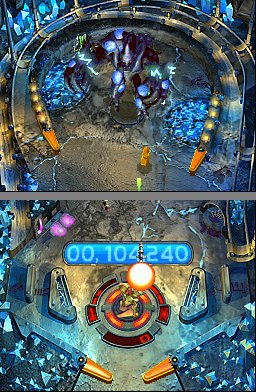
The controls in the game are simple and work very well. You control the right and left flippers by using either the R & L Shoulder Buttons or the Left Button on the control pad (left flipper) and the A Button (right flipper).
Pressing the B Button will drop Bombs. And (once you have obtained them) pressing the Y Button will let off a Power Bomb while pressing the X Button will shoot missiles when in Combat Mode.
You can also rub the touch-screen to “bump” the table. This is somewhat awkward since you have to take one hand off the system’s buttons to stroke the screen with your finger (or a stylus if you want to hold it the entire time you’re playing, but it’s really not necessary) and unless you have really quick reflexes you will sometimes kill yourself by not getting to the flipper buttons in time when you trying to rub. But if you can get the hang of rubbing and how it effects the ball, then you’ll be in much better shape to avoid the ball rolling straight down the drain.
Obviously, the game wouldn’t be Metroid without some unique features taken from the Metroid series, and thankfully for us there are plenty! These include various elements, from random enemies that will come onto the playfield (like Metroids) to the ability to drop bombs at any time (except when in Combat Mode) by pressing the B Button to a slew of unique mini-games that will typically reward you with a necessary Artifact when completed.
To mix things up, Metroid Prime Pinball uses some very clever devices on the various game boards, these can be activated by shooting the ball into the said device, and how they effect the game differs wildly.
From bonuses like a bigger score or extra life, to multiple balls that will be on the table at once, to kickbacks and, of course, the life-saving “force field”, which is a line of electricity that appears between the flippers on the bottom of the board. Obviously the Force Field is one of the most useful power-ups in the game as it keeps the ball from going into the gutter and will literally save your life on more occasions than you can count. If you don’t have the Force Field activated you must play very cautiously as it’s very easy to lose a ball down the drain without it.
Probably the most useful device is the “Reward Scanner”. This looks like one of the spinners from the 3D Metroid Prime games. Entering it will activate a roulette that has many random prizes. The roulette will stop automatically after a time, or you can press the B Button to drop a bomb and stop the roulette. Prizes include:
Health Recharge: Obviosly recharges your health.
Big Points: Adds between 30,000 and 50,000 points to your score.
Phazon Multiball: Gives you two Phazon-powered balls to play with, one red and one blue, also adds random blue and red targets on the playfield that can only be activated with the ball of the same color. The targets add points to your score.
Combat Ready: Activates the Combat Saucer.
Force Field: Activates a bolt of electricity between the bottom flippers. It stays until touched 3 times by the ball or until a certain elapsed period of time.
Missile Recharge: Recharges your Missiles if you have acquired them.
Power Bomb: Gives you a Power Bomb if you have acquired it.
Bounty Multiplier: Same as a Jackpot or normal Bounty increase, this adds points to your end-game Bounty score.
Kickback Ready: Gives you a new kickback device on both sides of the gutter to prevent the ball from going down the drain.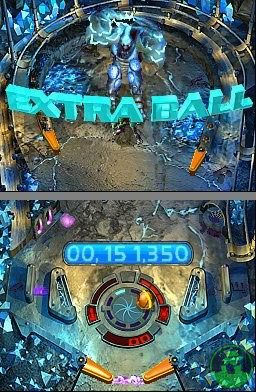
But the coolest aspect of Metroid Prime Pinball comes from the various mini-games. Most of these are activated by entering a device called the “Mode Saucer”. This device has a halogram above it dictating which mini-game you’ll play. The most common way to win Artifacts is to beat the mini-games, and remember you need 12 of them to unlock the final stage where you will face the last boss.
Some of the mini-games are:
Wall Jump – Use the R&L Buttons to make Samus flip from one wall to the other. Destroying enemies in your path gives you more points, at the top you collect an Artifact on the first go, and an extra ball on the second.
Clone Multi-ball – Two extra balls appear in the bumper area from tubes. Keep these in play for as long as you can and try to shoot them up the ramps over and over again to win a huge amount of jackpots and super-size your score. Once you lose two balls the mode is over.
Parasite Purge – Bugs fall all over the field, you have to destroy them within a time limit from the Combat Saucer.
Phazon Multiball – A red & blue ball appear along with several red or blue targets. A target can only be hit by a ball of the same color for points. Get enough points to pass & earn the Artifact
Metroid Mania – Metroids appear, destroy them (3 at level 1) by hitting them with the ball or dropping bombs (or shooting missiles) to get an Artifact.
Triclops Terror – A few Triclops creatures drop from above. These little guys have big pinchers on their front from which they will grab you and toss you towards the drain. Smack into them from the other side or use bombs to destroy them and win.
In addition to the above mini-games, you’ll also play many other ones that use Combat Mode. To enter Combat Mode, you roll over the Combat Saucer (when it has been activated).
In this mode, Samus will morph back into her human form, and in the various mini-games that use Combat Mode, various creatures will start coming towards you from the top screen while Samus shoots an endless amount of bullets automatically. You have to use the left and right buttons to maneuver her back and forth to destroy the oncoming creatures. In addition, you can use Missiles if you have obtained them.
You cannot move Samus onto the playfield, she stays on the Saucer, but these are still fun and challenging mini-games, to win you must destroy all the enemies that come towards you, get hit more than three times and you’ll fail the mode (at which point Samus will revert back to Ball mode and the pinball game will continue like normal).
All the mini-games are fun and go a long way in adding not only Metroid flavor but a cool break from the typical pinball gameplay. Each of them has more than one level, and they get increasingly more challenging the higher the level. If you have obtained 10 Artifacts and complete a mini-game, then you’ll be rewarded with a “Special” icon (which you can receive many times over) which is worth 50,000 points, you can also earn extra balls by completing some mini-games after you have obtained an Artifact from that game. 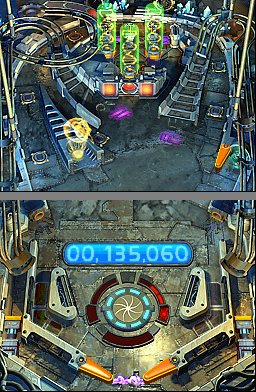
The last unique thing about Metroid Prime Pinball are boss fights. And boy are there plenty of them!
Actually, stages are divided between “Adventure” tables and “Arena” tables. The Adventure tables are the two default tables you start off on, Tallon Overworld and Pirate Frigate, Arena Tables are literally based around boss fights. Tables like Phendrana Drifts and Phazon Mines, where the top screen will have the boss who will walk around and throw attacks at you, draining your health. They must each be tackled in different ways and I won’t ruin it by revealing how to beat them here.
To get to another table you have to play until the Mode Saucer’s halogram shows an arrow. When this happens, shoot your ball into the Arrow and you will go to the teleport screen, where you can select from a number of other tables (or re-select the one you are in, in which case you will automatically enter a mini-game. It’s best to re-select the same table if you are low on lives, cause it’s sometimes easier to earn lives on the two adventure tables).
The only way to get the final two artifacts is to beat the bosses on both the Phendrana Drifts and Phazon Mines tables. Once the boss is beaten, you’ll automatically be teleported out of the stage and back to the select screen. The bosses are a cool feature, and while most of them can be beaten by simply shooting your ball into them, a few of them will require you to do something else. Regardless, they offer another unique spin on pinball.
Graphically, Metroid Prime Pinball looks excellent. It captures the look and the feel of Metroid Prime perfectly. The graphics are sharp and have some neat effects like fog and rain. Samus herself looks very good as well, and there are is even a brief cinema scene in the game that looks nice while it lasts.
It’s actually amazing to me how accurate they were able to get Prime Pinball to look compared to it’s console cousin, in fact many of the layouts for the pinball tables are so perfectly fit that it seems like you could insert them directly into Metroid Prime and you wouldn’t bat an eye. They’re that accurate. And there’s some cool touches as well, like how you can see the rest of the table from the wall-jump mini-game, and how the tables incorporate elements from Prime like Samus’ Ship.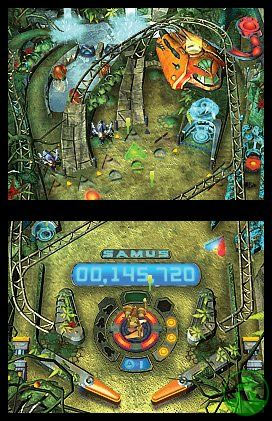
And like the graphics, the music fits perfectly, although that’s because most all of the tunes are directly lifted from Prime itself and recreated here on the DS. From the title screen music to the music of the individual stages, there isn’t a whole lot of tunes but what’s here is good and feels like Metroid Prime. Which would be the goal the developers had in mind, I imagine.
The game even ships with an included Rumble cart accessory. This slides into the GBA slot and will shake and rumble to the action as you play Metroid Prime Pinball on your DS. The rumble pack may feel weird at first, but after giving it a shot I got used to having it in and it’s actually quite effective. I did notice when I quite playing without it, and it’s just a cool touch to have that kind of “feeling the bump” action while you’re playing the game. So while I wouldn’t buy the game for the Rumble cart, it is a very nice bonus.
Replay value-wise, Prime Pinball doesn’t have a lot of “meat” to it necessarily, especially given the fact that there are only two modes. The multiplayer mode of course helps, but the people who will get the most out of this game are those that love to beat their own scores. Since scores are kept overall for both the Multi-Mission mode and for each individual table there will be a ton of scores to go around and try to beat. It keeps track of ten scores for each and you are allowed to enter your initials as well so that everyone knows who they are competing against.
Overall Metroid Prime Pinball is an excellent pinball game. It is well made, fun and very unique. The physics of the ball are also spot-on, and the power-ups seem to give you exactly what you need when you need it, which goes a long way in keeping you in play, which in turn increases that score ever higher.
If you are in any way into pinball games or beating your high scores, or you just want to see what a pinball take on Metroid is like, then you owe it to yourself to pick Metroid Prime Pinball up. It’s one of those games that can be played for hours at a time, or for quick matches in Single Mission mode. A solid title to add to any DS collection.
FUN FACTOR – 9.0
A very unique, fun pinball game that takes all the best aspects of Metroid Prime and uses them to enhance the game of pinball. 
Graphics – 9.0
Very sharp and they resemble those of the console Prime’s better than you’d probably imagine. Pinball physics are also excellent.
Music & Sound – 9.0
Fits in perfectly with the Prime games, many of the tunes in fact are directly lifted from the original console Prime. There’s even a lot of voice work for names of tables and to announce mini-games, this is nice cause the original Metroid Prime had hardly any voice acting, and obviously it fits well here. Sound effects are very good and just as you’d expect.
Presentation – 9.0
Metroid Prime Pinball is presented excellently. The menu screens have the same feel as the title screen from Metroid Prime, and the music works well. The voice overs are nice and overall the presentation feels sleek.
Ingenuity – 8.0
It’s pinball with lots of Metroid thrown in . . . but it’s mixed well. None of the Metroid elements feel out of place in the least and everything is built nicely. The Metroid elements also all enhance the game and I can’t think of single complaint with it.
Replay Value – 7.0
There are only two single-player modes and one multiplayer. Multiplayer is simply a high-score competition where you can send enemies to the other boards for up to 8-players. You can play with one game card but it’s only local and not online. As is, those that like to beat their own scores will find a lot of replay value here, and the game is also quite challenging, it took me a lot longer than expected to finally beat the Multi Mission mode since it has to be done in one go. For those that love pinball, they’ll find a lot to like here. And enough to keep them playing for a while. If you don’t like pinball, it’s not gonna do anything for you and you likely won’t keep playing after beating it. Cause in the end, it is simply a virtual pinball game.
